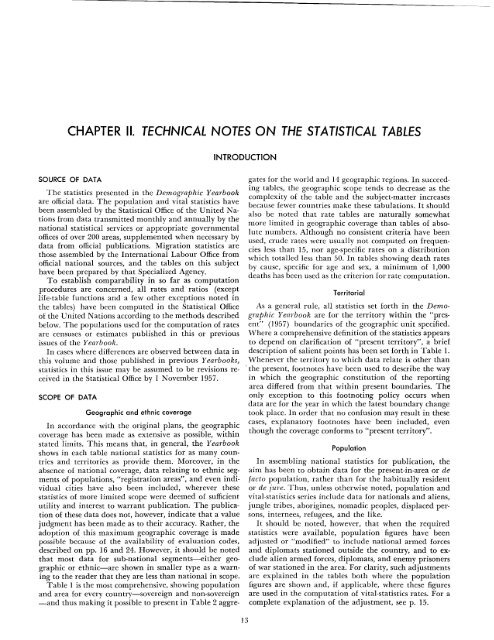1957 - United Nations Statistics Division
1957 - United Nations Statistics Division
1957 - United Nations Statistics Division
You also want an ePaper? Increase the reach of your titles
YUMPU automatically turns print PDFs into web optimized ePapers that Google loves.
CHAPTER II. TECHNICAL NOTES ON THE STATISTICAL TABLES<br />
SOURCE OF DATA<br />
The statistics presented in the Demographic Yearbook<br />
are official data. The population and vital statistics have<br />
been assembled by the Statistical Office of the <strong>United</strong> <strong>Nations</strong><br />
from data transmitted monthly and annually by the<br />
national statistical services or appropriate governmental<br />
offices of over 200 areas, supplemented when necessary by<br />
data from official publications. Migration statistics are<br />
those assembled by the International Labour Office from<br />
official national sources, and the tables on this subject<br />
have been prepared by that Specialized Agency.<br />
To establish comparability in so far as computation<br />
procedures are concerned, all rates and ratios (except<br />
life-table functions and a few other exceptions noted in<br />
the tables) have been computed in the Statistical Office<br />
of the <strong>United</strong> <strong>Nations</strong> according to the methods described<br />
below. The populations used for the computation of rates<br />
are censuses or estimates published in this or previous<br />
issues of the Yearbook.<br />
In cases where differences are observed between data in<br />
this volume and those published in previous Yearbooks,<br />
statistics in this issue may be assumed to be revisions received<br />
in the Statistical Office by 1 November <strong>1957</strong>.<br />
SCOPE OF DATA<br />
Geographic and ethnic coverage<br />
In accordance with the original plans, the geographic<br />
coverage has been made as extensive as possible, within<br />
stated limits. This means that, in general, the Yearbook<br />
shows in each table national statistics for as many countries<br />
and territories as provide them. Moreover, in the<br />
absence of national coverage, data relating to ethnic segments<br />
of populations, "registration areas", and even individual<br />
cities have also been included, wherever these<br />
statistics of more limited scope were deemed of sufficient<br />
utility and interest to warrant publication. The publication<br />
of these data does not, however, indicate that a value<br />
judgment has been made as to their accuracy. Rather, the<br />
adoption of this maximum geographic coverage is made<br />
possible because of the availability of evaluation codes,<br />
described on pp. 16 and 24. However, it should be noted<br />
that most data for sub-national segments--either geographic<br />
or ethnic-are shown in smaller type as a warning<br />
to the reader that they are less than national in scope.<br />
Table 1 is the most comprehensive, showing population<br />
and area for every country-sovereign and non-sovereign<br />
-and thus making it possible to present in Table 2 aggre-<br />
INTRODUCTION<br />
gates for the world and 14 geographic regions. In succeeding<br />
tables, the geographic scope tends to decrease as the<br />
complexity of the table and the subject-matter increases<br />
because fewer countries make these tabulations. It should<br />
also be noted that rate tables are naturally somewhat<br />
more limited in geographic coverage than tables of absolute<br />
numbers. Although no consistent criteria have been<br />
used, crude rates were usually not computed on frequencies<br />
less than 15, nor age-specific rates on a distribution<br />
which totalled less than 50. In tables showing death rates<br />
by cause, specific for age and sex, a minimum of 1,000<br />
deaths has been used as the criterion for rate computation.<br />
Territorial<br />
As a general rule, all statistics set forth in the Demographic<br />
Yearbook are for the territory within the "present"<br />
(<strong>1957</strong>) boundaries of the geographic unit specified.<br />
\Vhere a comprehensive definition of the statistics appears<br />
to depend on clarification of "present territory", a brief<br />
description of salient points has been set forth in Table l.<br />
Whenever the territory to which data relate is other than<br />
'the present, footnotes have been used to describe the way<br />
in which the geographic constitution of the reporting<br />
area differed from that within present boundaries. The<br />
only exception to this footnoting policy occurs when<br />
data are for the year in which the latest boundary change<br />
took place. In order that no confusion may result in these<br />
cases, explanatory footnotes have been included, even<br />
though the coverage conforms to "present territory".<br />
13<br />
Population<br />
In assembling national statistics for publication, the<br />
aim has been to obtain data for the present-in-area or de<br />
facto population, rather than for the habitually resident<br />
or de jure. Thus, unless otherwise noted, population and<br />
vital-statistics series include data for nationals and aliens,<br />
jungle tribes, aborigines, nomadic peoples, displaced persons,<br />
internees, refugees, and the like.<br />
It should be noted, however, that when the required<br />
statistics were available, population figures have been<br />
adjusted or "modified" to include national armed forces<br />
and diplomats stationed outside the country, and to exclude<br />
alien armed forces, diplomats, and enemy prisoners<br />
of war stationed in the area. For clarity, such adjustments<br />
are explained in the tables both where the population<br />
figures are shown and, if applicable, where these figures<br />
are used in the computation of vital-statistics rates. For a<br />
complete explanation of the adjustment, see p. 15.
















